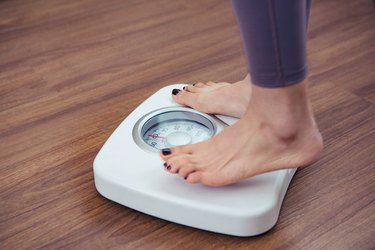
So you've joined WeightWatchers and started your get-healthy journey, but there's one big question you still need to answer: How much weight, exactly, should you aim to lose?
Choosing the best goal weight may seem complicated, but WeightWatchers suggests starting with a specific formula: 10 percent of your total weight.
Video of the Day
Video of the Day
According to WeightWatchers.com, those with overweight that drop just 10 percent of their body weight can reduce their risk of type 2 diabetes and are likely to lower their cholesterol and blood pressure, too. And per the Obesity Action Coalition, you might even sleep better with slightly less weight on your frame. A loss of 5 to 10 percent of your body weight may improve obstructive sleep apnea, a condition that causes some people to pause and gasp for breath during the night.
And when you lose 10 percent of your body weight, you'll also probably feel better about yourself (achieving a goal like this is cause for celebration!), which can help you stay positive if you've got more weight to lose.
How to Calculate Your Goal Weight
While your "ideal weight" is ultimately something that you should discuss with your doctor, there is a quick equation you can use to get an estimate of where each of your weight-loss goals should fall.
Remember: there are so many different factors involved in weight regulation and weight loss; it can be difficult (and even unhealthy for some) to get to their perceived "ideal weight."
Instead, it's best to aim for that 5 to 10 percent weight loss with associated positive health markers. Determine that with the equations below:
1. Your Initial Goal. Calculate your 10 percent weight-loss goal by multiplying your current weight by .10. Take the calculated number and subtract it from your current weight to determine your initial goal weight. For example, if you weigh 250 pounds: 250 x .10 = 25. When you subtract 25 from 250, you get 225, which is your initial goal weight.
2. Your Final Goal. Once you've lost that 10 percent, calculate your final goal by first determining your frame size: 5 for thin, 6 for average, 7 for large. Multiply the number of inches tall you are over 5 feet by your frame size. Add this calculation to 100 to determine your approximate final goal. For example, a 5-foot 8-inch person with an average frame would multiple 8 x 6, and then add 100, for an approximate goal weight of 148 pounds.
Tip
These formulas are meant to help you calculate approximate goal weights. Be sure to work with your doctor to determine the healthiest goal weight for you. Your "ideal weight" will be one that is healthy for your body frame, size, genetics and your overall health.